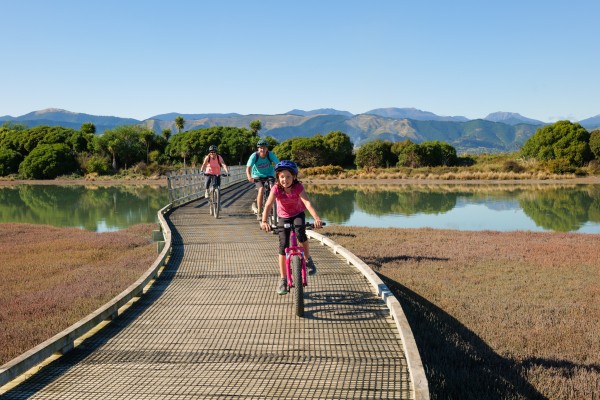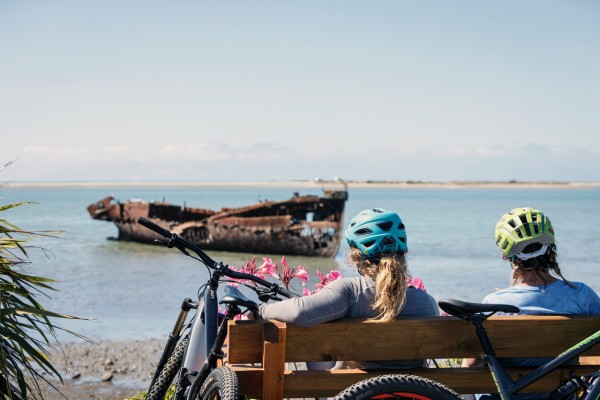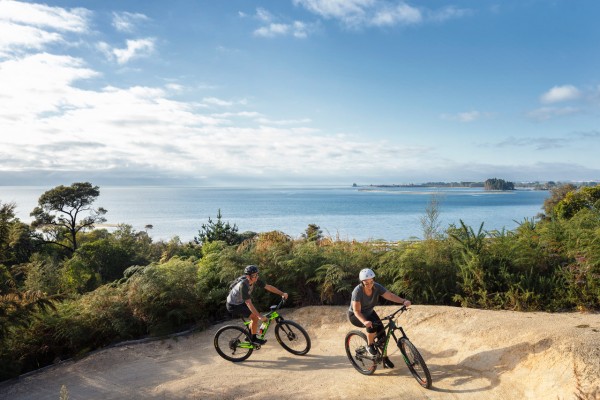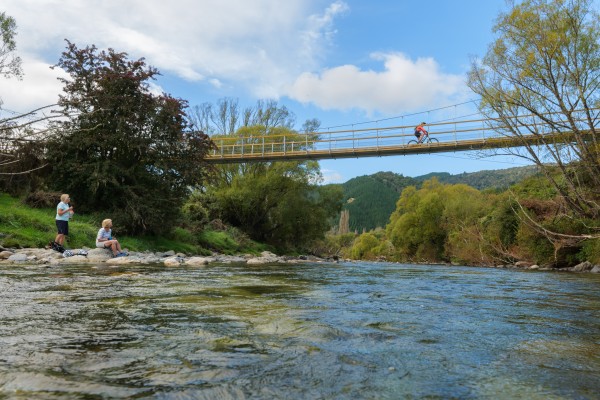Looping through the towns of Nelson, Wakefield, Richmond, Motueka and Kaiteriteri, the Tasman's Great Taste Trail is a terrific way to tour the attractions of this popular holiday destination.
Its mix of rural, urban, coastal and riverside scenery is a fabulous feast for the eyes. Natural beauty, however, is only part of the appeal, with this trail serving up a tantalising array of tasty attractions – from art galleries and boutique shopping, to fruit stalls, cafes, craft beer pubs and winery restaurants.
Forming a big loop around the Nelson–Tasman region, the trail can be enjoyed in full over several days or dipped into on short hops and day rides. Base yourself in one place or overnight along the way – either way you’re set for a super-sweet sightseeing tour with flavours to suit almost anyone.
- beaches including glittering Kaiteriteri
- fruit stalls, fish & chips, pie shops, ice cream
- pretty vineyards & wine tasting
- artist studios – glass-blowing, ceramics, painters & more
- native & migratory seabirds
- Mapua’s riverside village precinct
- historic (and spooky!) Spooners railway tunnel
- vibrant Nelson city
- Motueka – gateway to the Abel Tasman
- craft beer made here – ‘the home of hops’
A big, beautiful loop taking in Nelson, Wakefield, Motueka and Kaiteriteri (amongst other settlements) the Great Taste Trail is readily accessible along its full length. This makes for countless return ride and loop options, along with handy bike hire depots and shuttle services making it easy to tailor a trip to suit your itinerary and interests. But no matter how you slice and dice it, be sure to allow plenty of time to stop and enjoy the sights.
On-trail signage ensures wayfinding is clear, while the trail website (and Facebook page) detail the latest updates.
Here we describe the trail effectively in its two ‘branches’ – the coastal section (more or less) from Nelson to Kaiteriteri; and from Wakefield through to Riwaka via the inland foothills, Tapawera and the Motueka Valley.
Nelson—Mapua
35km, Grade 2/easy, 2–3 hours
This section starts at Nelson i-SITE and heads in the direction of adjacent Richmond town via the railway reserve cycleway.
After a gentle up-and-over, it exits the central city and follows a waterside pathway between Nelson’s major highway and light industrial area, and the bird-filled Waimea Inlet. Suffice to say, it’s best to look seaward: this is in fact the largest enclosed estuary in the South Island, home to a wide range of sea birds including the bar-tailed godwit, white heron, royal spoonbill, little egret, Australasian bittern and banded rail.

The pretty bird-filled Waimea Estuary (Chocolate Dog Studio).
As the trail nears Richmond it splits in two, with the right fork leading towards Mapua on a mix of quiet lanes and a stopbank track. It then crosses the Waimea River via a purpose-built suspension bridge.
(At Richmond, the straight-ahead option leads to the town centre and further inland via the Wakefield section.)
The trail then crosses a causeway to Rabbit Island/Moturoa, a popular recreation area with picnic spots, fragrant pine forest and sandy beaches. It’s a pleasant cruise across the island to reach the ferry landing from where it’s just a 200m boat hop to Mapua wharf. Infrequent sailings make it essential to check the ferry timetable ahead of time.
Mapua is a particularly appealing stop along the Great Taste Trail. It’s waterside location, accommodation, cafes, brewery and shops are good reasons to consider a lengthy linger or overnight stop.
Mapua—Motueka
26km, Grade 2/easy, 2–3 hours
Having left Mapua via quiet streets, the trail rejoins the shore along Ruby Bay but soon leaves it again to head into rolling hill country.
Most folks will find it a comfortable granny-gear climb to a highpoint where there are panoramic views across to the western ranges and big blue of Tasman Bay.
There’s plenty more time take it all in as trail gradually descends via the aptly named Tasman View Road. After a few turns left and right along more country roads you’ll arrive at Motueka – a lovable little town surrounded by endless fruit orchards and hop gardens. If you’re looking for local flavour, you’ll find it here.

The Motueka shipwreck – a picture-perect photo-op! (Virginia Woolf Photography).
Motueka—Kaiteriteri
16km, Grade 2/easy, 1–2 hours
Boasting a mouthwatering blend of rural and coastal scenery and opportunity to taste yet more local flavours, this section starts with the salt-licked sights of Motueka’s seafront then crosses the impressive Motueka River.
The trail then follows pretty country lanes to reach Riwaka where you should keep your eyes peeled for a pie shop, cafe, brewery and fruit stalls. Be warned that if you ate before setting off from Motueka, you could still be too full for a Ginger Dynamite pie…
(Riwaka is the junction of the inland trail heading up the Motueka Valley towards Norris Gully.)
The trail continues through fruity country to meet a lovely stretch of coastal pathway, at first winding over bridges and boardwalk. A gentle climb reveals stupendous views right across Tasman Bay.
An underpass provides safe access to Kaiteriteri Mountain Bike Park. Even riders without much ‘mountain biking’ experience should enjoy the gently rolling and sweeping route through to Kaiteriteri village.
Kaiteriteri Beach’s glorious golden sands teem with holidaymakers in summer. The waterfront cafe is a good spot to take it all in. Various Abel Tasman National Park adventures also start from here.

Nice berms in the Kaiteriteri MTB Park (Virginia Woolf Photography).
Richmond—Wakefield
17km, Grade 1/easiest, 1–1.5 hours
This section of the Great Taste Trail heads off on an inland tangent, taking in the country settlements of Brightwater and Wakefield. If you are prepared to explore off the trail here there are several wine tasting opportunities here, as detailed on the Wine Nelson trail.
Rich in history and home to 2000 people, Wakefield is a pleasant place to rest a while or break your journey overnight. It’s also possible to ride back to Richmond, with an alternative route described in the Day Rides section, below.
Leaving Richmond (bottom Queen Street), the trail passes through vineyards to reach Ranzau Road, then turns a couple of corners to meet Pugh Road and eventually the Waimea River. An impressive suspension bridge takes you to the other side.
Off the bridge, it’s a left turn towards Brightwater, a welcoming place to stop for refreshments before heading onward.
Charlotte Lane leads riders out of Brightwater, through an underpass, on to Lord Rutherford and Higgins Roads and into the heart of Wakefield village via Edward Street. All signposting is clear.
Wakefield—Tapawera
31km, Grade 2/easy, 2–3 hours
After stopping for refreshments in Wakefield follow the signs to cross SH6 and the Wai-iti River before turning left onto the purpose-built trail, which follows the river for 3.5km through pockets of native bush. Cross the river on the epic swing bridge – spanning almost 50m – then continue between the river and hop vines to Hoult Valley Road.
From here, the trail crosses SH6 and follows a 1.4km stretch beside the highway to reach Wai-iti Domain, and then continues on a dedicated cycle path to reach Belgrove. Check out the Belgrove Railway Windmill (built 1897) as you pass through town.
The trail shadows the road for a while then joins the old Nelson Railway route through pastoral countryside and past historic tobacco kilns until it reaches seriously spectacular Spooners Tunnel.
The railway line was in use up until 1955, when its closure was met by major protests. One agitator was the trade unionist, politician and feminist Sonja Davies. Davies and other local women sat on the tracks for six days, even defying an oncoming locomotive. Alas, the line was closed.
On the upside, the 1400m-long Spooners Tunnel is now New Zealand’s longest decommissioned rail tunnel. It’s also the sixth-longest pedestrian and cycle tunnel in the world, and the longest in the southern hemisphere.
Suffice to say, it’s pretty dark in there, so you’ll need to carry a torch if you want to survey the interior and avoid getting spooked, although we think a spot of spookiness is all part of its charm. A warm layer is also needed as it gets quite cold, particularly in the middle and obviously more so in winter.
Another 7km takes you down to Kohatu junction (passing the Norris Gully car park along the way) where the trail meets the road down the Motueka Valley. This is a good place for refreshments at the Flat Rock Cafe.
From Kohatu riders join an 8km section of off-road trail paralleling the road towards the sweet wee settlement of Tapawera, where there’s a cafe, pub, shops, and the tiny Tapawera Museum located in the old railway station. On the way is the Hidden Sculpture Garden – a good place to stop for a look at the fascinating outsize artworks, and grab a cuppa.
Tapawera—Riwaka
63km, Grade 3/intermediate, 3–6 hours
If you're seeking valleys and mountains, join the trail at Tapawera and make sure you are fuelled up for this section as there are few options for re-supply from Riwaka through to Tapawera. Note also that this section is more challenging with some climbing and gravel roads.
The trail from Tapawera to Woodstock is on rural gravel road, shared by vehicles including logging trucks and milk tankers. Please keep left at all times and take care as there are sections of loose gravel. If you are on an e-bike make sure you have sufficient battery for the route, which includes a hill climb. You are in the back-country and there are no charging facilities.
From Tapawera there is a 15km stretch on gravel road up to the Baton Saddle and then a satisfying descent to the beautiful Baton River swing bridge, purpose built for cyclists. The trail then follows the Baton Valley Road for 14km to Woodstock.

The graceful Baton River bridge (Chocolate Dog Studio).
From the Woodstock bridge, it’s 27km along the pretty West Bank Road to Brooklyn. The road is relatively narrow but has light traffic volumes.
At Brooklyn, it’s a right turn onto Old Mill Road, left onto Anderson Road, straight across Umukuri Road, on Swamp Road, and then right into Factory Road to reach the junction with SH60 at Riwaka. The cycle trail (Kaiteriteri to Motueka section) is across the road.
Numerous access points and convenient bike hire make it easy to get a taste of the trail – as one-way rides with shuttle pick-ups, or return rides and loops factoring in alternative routes. Here are some ideas.
Nelson—Mapua
35km, easy, 2–3 hours
This is one of the trails’ classic day trips, starting in central Nelson (where there’s bike hire) and taking in Waimea Estuary and Rabbit Island scenery along the way. The Mapua ferry is a neat way to finish the trip, as is a meal, beer or a spot of shopping in the waterside village.
Motueka—Kaiteriteri (return)
32km, easy, 2–3 hours
A ride to Kaiteriteri and back is a lovely option from Motueka (where there’s bike hire), offering both bucolic and bayside scenery along with fruit stalls, a brewery and cafes, plus the golden sands of Kaiteriteri Beach. It also traverses the smooth, main trail through Kaiteriteri MTB Park – a chance to feel the ‘flow’ of expertly built mountain tracks if you’ve never had that buzz before.
Stoke—Brightwater (return)
28km, easy, 2–3 hours
This ride will be enjoyed by lovers of wine tasting, rural scenery and charming country towns – so allow a full day if you’re inclined to dally. Conveniently, you can catch a scheduled bus from central Nelson to the starting point at Stoke (9km) and hire a bike there. The Great Taste Trail heads inland across the pretty Waimea Plains, with five wineries to visit just a hop away. Have a cuppa in Brightwater and visit the memorial to Ernest Rutherford (the New Zealander who split the atom who was born around here) before returning to Stoke. Eager riders can continue on to Wakefield through what is a particularly pretty section of trail; return shuttles are available to get you home again.
Spooners Tunnel (between Belgrove & Kohatu)
up to 30km, easy, 1–3 hours
If you want a taste of the trail and an interesting historic outing, park your car at Wai-iti Domain, the car park adjacent to the Belgrove pub, Norris Gully or Kohatu. From each of these places there are signs and off-road trail to Spooners Tunnel (and back again) for a safe ride or walk.
TRAIL STATUS & ALERTS
For current trail status and any alerts – such as temporary track closures and detours – check the trail website.
FITNESS & SKILLS
Riders of most ages and abilities can enjoy the Great Taste Trail. Graded 1–2, it is mostly smooth and flat with a few hilly sections requiring a bit more effort. The terrain is predominantly gravel or sealed cycleway, or country lanes and roads with little traffic. There are, however, some busy intersections, plus busy country roads along the inland sections where riders must take particular care.
TYPE OF BIKE
A hybrid bike is suitable unless you plan tackling the Kaiteriteri MTB park with gusto.
E-bikes are also permitted and available through most bike-hire companies. E-bikers should ensure that batteries have sufficient capacity and charge for the day's riding and, if staying in local accommodation, check that they can be recharged there. Note: there is now an e-bike charging station at Kaiteriteri at the campground. Enquire at reception.
MAPS & NAVIGATION
Although the trail is well signposted and never far from main roads and settlements, carrying a map will enhance the experience by pinpointing landmarks and assist with timings for shuttle pick-ups, etc. The map can be downloaded from the trail website.
You can also download the awesome Great Rides App to see where you are on the trail. It's free, works offline and has heaps of useful information, including trail descriptions and photos, trail services, food and accommodation.
MAPUA FERRY
The 200-metre, 7-minute ferry journey across Mapua Inlet is a vital link in Tasman's Great Taste Trail, taking riders between Rabbit Island and Mapua Wharf and back again. The ferry is purpose-built to accommodate cyclists and foot passengers. The ferry is the only way to make the crossing; the alternative route is a hilly 15km via busy SH60 and not recommended. The ferry runs on a limited timetable, particularly over the winter months; note that any cancellations (largely due to high winds and/or rough sea) will be advised on their Facebook page.
WEATHER & RIDING SEASON
The Nelson–Tasman region is blessed with balmy summers and bright, mild winters, making for great riding at any time of year. Riders should, however, always check the forecast and pack clothing for all possibilities. A lack of shade along some parts the trail make sunscreen (and a sun hat when off the bike) essential in summer, and advisable the rest of the year, too.
FOOD & DRINK
They don’t call this the Great Taste Trail for nothing, with many sections of trail boasting an enticing range of cafes, wineries, breweries and other delicious pit stops. Many more can be discovered with a bit of extra exploration. Popular eateries can get pretty busy in peak season (January–March); conversely, the winter months see some reduce their operating hours. Ask the locals about what to expect, and make table reservations as required.
Some stretches, particularly along the inland sections, have little to offer in the way of refreshments, so plan ahead and pack plenty of snacks and drinks. Water bottles can be filled at various settlements; be sure to carry plenty on hot summer days.
CELLPHONE COVERAGE
Cellphone coverage is good across the coastal section of the trail network. There are gaps in reception on some of the inland sections south of Wakefield and Motueka.
TOILETS
Toilets are located at convenient points along the trail.
DOGS & HORSES
Dogs, on leads, are permitted on most sections of the Great Taste Trail, except for Rabbit Island and where signage indicates (visit the Nelson City Council and Tasman District Council websites for more details).
Horses are not permitted on the sections of trail specifically constructed for cycling/walking use.
A popular holiday destination for both New Zealanders and overseas visitors, the Nelson–Tasman region is well set up for visitors. It will pay to book travel and accommodation well in advance for the busy summer season, December–March. Although tourism winds down in the depths of winter, a great year-round climate and the popularity of Abel Tasman National Park means that many visitor services operate all year round.
View all trail partners
GETTING HERE
Nelson is the main gateway to the Great Taste Trail, with Nelson the primary transport hub with a busy regional airport. The nearby towns of Richmond and Motueka also lie on the trail.
Nelson is also less than two hours’ drive from the ferry port of Picton via the extremely scenic Queen Charlotte Drive, but it’s fair to say that the whole top of the South Island makes for a brilliant road trip. Marlborough wine country, Kaikoura marine life, Golden Bay, plus three national parks (Abel Tasman, Kahurangi and Nelson Lakes) are just some of the highlights that can be factored in.
Christchurch, with its international airport, is a terrific place to launch a road trip, being around six hours’ drive from Nelson via Kaikoura and Blenheim, or the beautiful Lewis Pass.
Nelson, Richmond, Motueka and other significant highway towns are served by nationwide Intercity Buses. Small destinations can be reached via the region’s public bus network, and smaller shuttle operators offering customised trips.
BIKE HIRE, TRANSPORT & TOURS
The Great Taste Trail is well served by shuttles and cycle tour companies offering everything from bike hire and transport, to fully packaged independent and guided tours factoring in off-the-bike activities such as hiking in Abel Tasman National Park.
Several national bike tour companies offer customised tours of popular South Island cycle trails including the Great Taste Trail, West Coast Wilderness Trail and Queen Charlotte Track, with Christchurch a popular departure point for international visitors.
Find bike hire, transport & tours
ACCOMMODATION
There are plenty of accommodation options in Nelson and Motueka, and close to the full trail particularly in visitor hotspots like Mapua and Kaiteriteri. Smaller, rural settlements also boast some highly atmospheric options, mostly small-scale and family run.
Great Rides of New Zealand national partner Heritage Hotels has an awesome property – the Rutherford Hotel – right in the heart of Nelson. Use the code 'NZCYCLE' when you book and get a 10% discount.
The Nelson–Tasman region gets particularly busy January through March, so be sure to book well in advance for this season; also be aware that some providers close down in mid-winter due to low demand.
Find accommodation
VISITOR INFORMATION



